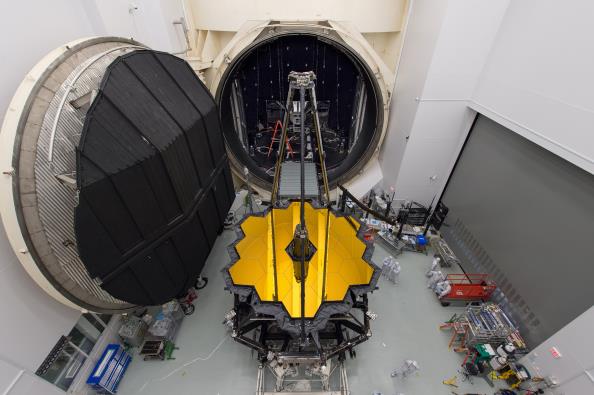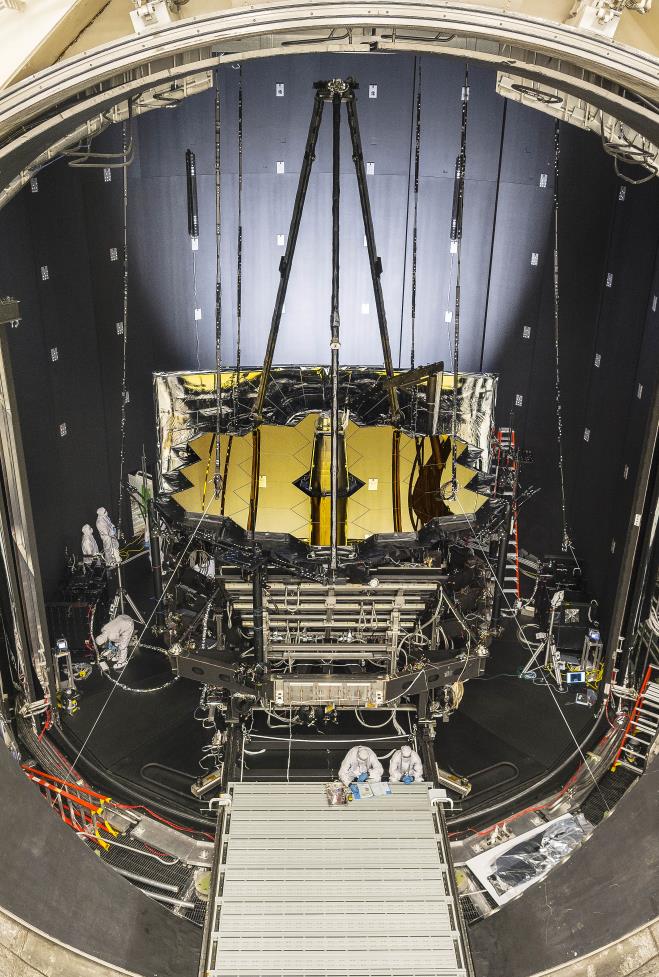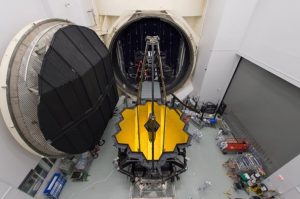The James Webb Space Telescope (JWST) has reached a key milestone with the completion of cryogenic tests on its telescope and instruments. Working within an international consortium, France, in particular the CEA, the CNRS and the CNES, has played a key role in the development, for the scientific successor to the Hubble and Spitzer space telescopes, of the Mid-InfraRed Imager (MIRIM) that will enable it to see wavelengths of 5 to 28 microns.

Heavy tests at a temperature of – 253°C
A French team took part in the full-scale tests recently completed on the James Webb Space Telescope (Webb), the successor to the Hubble Space Telescope. Webb is a programme being led by NASA in partnership with Europe (through the European Space Agency, or ESA) and Canada.
For these cryogenic tests, which began on August 22nd and ended on September 26th, the telescope and its instruments were placed inside the giant vacuum chamber (Chamber A) at NASA’s Johnson Space Center in Houston, Texas. This is the only cryogenic chamber in the world large enough to house the telescope and its 6.5-metre mirror (by comparison, Hubble’s mirror spans just 2.4 metres). Then, Webb was slowly heated up and pressurized again to allow the reopening of the chamber.
Inside the chamber, the temperature is cooled to as low as –253°C. The chamber also has a star simulator, a device consisting of infrared fiber optics used to verify the optical quality and alignment of Webb’s mirror by comparing actual images obtained with simulated ones. This is the first time the telescope and instruments have been tested together. The instruments had previously undergone a series of three cryogenic tests on their own inside a smaller chamber (the Space Environment Simulator) at NASA’s Goddard Space Flight Center in Greenbelt, Maryland, from 2013 to 2016. “A number of French research laboratories are closely involved in one of the four instruments on Webb, the Mid-InfraRed Instrument (MIRI), and more especially its Mid-InfraRed IMager (MIRIM),” says Anne Peyroche, President of CNRS, the French scientific research centre. They are the LESIA space and astrophysics instrumentation research laboratory (Paris Observatory-CNRS-UPMC-Paris Diderot University), the LAM astrophysics laboratory in Marseille (CNRS-AMU), the IAS space astrophysics institute (CNRS-Paris Sud University) and the AIM astrophysics joint research unit (CEA-CNRS-Paris Diderot University), with CEA’s Institute of research into the fundamental laws of the Universe (Irfu) as prime contractor. Oversight is being assured by CNES.

A 10 years adventure
MIRIM left Saclay for the Rutherford Appelton Laboratory (RAL) in the UK in 2009 after undergoing a series of tests showing that it met the required specifications. It was then coupled to the MIRI spectrometer, developed mainly by the Netherlands and the United Kingdom and again, a series of cold checks was carried out before sending to Goddard in 2012, where MIRI was integrated with the other three instruments of the JWST.
Today, this trip is not over yet. Next step, California where the telescope will be equipped with its thermal shields then everything will be set up on the satellite platform. All will then sail to Kourou, French Guiana. It is here that Jean-Yves Le Gall, president of CNES, project manager of MIRI, gives “rendezvous to this telescope, whose success in cryogenic tests illustrates again the effectiveness of international cooperation in the field of space, for its last trip, where it will be launched in the spring of 2019 by an Ariane 5 launcher“. The JWST will finally reach its destination, at the Lagrange L2 point located 1.5 million km from the Earth, about 4 times more distant of the Earth than is the Moon. “In case of a problem, it will obviously not be a question of sending a team to fix it, as it may have been the case for Hubble. That's why the final tests conducted by our French experts on the JWST and its instruments are so important“, says Daniel Verwaerde, General Manager of CEA, prime contractor for MIRI.
Read more:
Contacts: Pierre-Olivier Lagage; Patrice Bouchet


